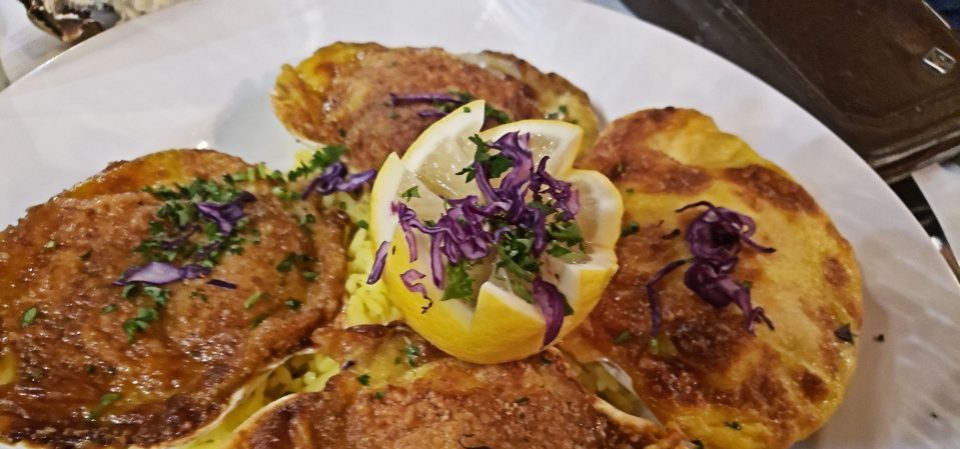Let’s start here. Clay pot cooking is a technique of cooking food in an unglazed clay pot which has been soaked in water so as to release steam during the cooking process. This technique has a long history, stretching back at least to ancient Roman times, and is commonly used in several cuisines in Africa, Europe and Southeast and East Asia. I will attempt to keep this discussion to two styles of clay pot coking: Römertopf and Tajine.
In Germany, the clay roaster used to cook with is called a Römertopf (literally “Roman pot”). Since its introduction in 1967, it has influenced cooking traditions in Germany and neighboring European countries. The pot is mainly used to cook meat, like pork roast, chicken or stew, in an oven. From Römertopf Online we learn,
Clay pot cooking is an easy, efficient, healthy cooking method that seals in nutrients and cuts down on the need for added fats. Simply by soaking the Romertopf roaster in water before placing it inside the oven allows it to create and maintain moisture that cooks recipes to perfection, while preventing the nutrients from escaping.
Römertopf cooking not only saves nutrients, but also saves time. Simply soak the Römertopf in water for 5-10 minutes, place ingredients inside and place the whole pot in a cold oven set at 400-450 degrees. Then just walk away. Workout with your favorite celebrity, play with the kids, or soak in the tub for the 45 minutes to an hour the Römertopf needs to cook your meal to perfection.
Römertopf clay pots are available in a variety of sizes, ranging from the smallest which holds 2-5 lbs to the Maxi, which holds a 17 lb Turkey. They are unglazed to ensure perfect absorption, so that ample moisture is available in the cooking cavity.
From Wikipedia Clay Pot Cooking, we find that “… The tajine is a North African, two-piece clay pot used in Moroccan cuisine. The bottom part is a broad, shallow bowl, while the top is tall and conical, or sometimes domed. The tall lid acts to condense rising steam and allow the moisture to roll back down into the dish. The tajine lends its name to the dish made in it, which in Morocco is a meat stew. Another clay pot used in Moroccan cooking is the tangia. The tangia is similar in appearance to a tall bean pot. It is used to cook a dish, also called tangia, that is traditionally all meat and spices, no vegetables or beans.”
As a side note, “A tangia (sometimes spelled tanjia) is a Moroccan urn-shaped clay cooking pot. The same word also refers to the meat dish which is cooked in the tangia … The tangia originated in Marrakesh, where its use is said to have been popularized by unmarried working men. Before heading to their jobs, they would season meat with onions, garlic and Moroccan spices, stuff the mixture into their tangias, and then drop off the clay vessels at the wood-burning ovens which provided heat to the local hammams (public bath houses). There, the tangias would be nestled into the deep ashes, allowing the meat to slow-cook until the workers retrieved them at the end of the day.
Although tangia may also be prepared by women of the home, in traditional Marrakesh circles it remains a specialty dish of men and a customary offering at male social gatherings.” As a side note, “… The tangia originated in Marrakesh, where its use is said to have been popularized by unmarried working men. Before heading to their jobs, they would season meat with onions, garlic and Moroccan spices, stuff the mixture into their tangias, and then drop off the clay vessels at the wood-burning ovens which provided heat to the local hammams (public bath houses). There, the tangias would be nestled into the deep ashes, allowing the meat to slow-cook until the workers retrieved them at the end of the day.
Although tangia may also be prepared by women of the home, in traditional Marrakesh circles it remains a specialty dish of men and a customary offering at male social gatherings.” [Moroccan Food]
Both styles of Clay Pot Cooking are similar. The pot designs are different but both are extremely effective in producing some fantastic meals. The tajine is designed so that the steam produced internally, circulates throughout the pot, condenses and runs back down into the food. From The Kitchen, “…The tagine’s conical shape makes a uniquely moist, hot cooking environment for the dish being cooked. The base is wide and shallow, and the tall lid fits snugly inside. As the food cooks, steam rises into the cone, condenses, and then trickles down the sides back into the dish.” The Römertopf, on the other hand, has no means to let the steam escape, therefore cooking with the steam and infusing the spices that you use in the product, be it chicken, beef, lamb or the like.
These are two very exciting and delightful ways of preparing a meal. Try these pots using chicken, pork, lamb, beef or maybe even fish – a whole fish. We like lamb shanks done in the tajine and chicken done in the Römertopf. Use high temperatures, 400 – 450 degrees F, and you will have a great meal. Enjoy and experiment with the styles. Both products, and some recipes, are available online or maybe even at your local Foodie Den, or better known as a cooking store. Cheers!


